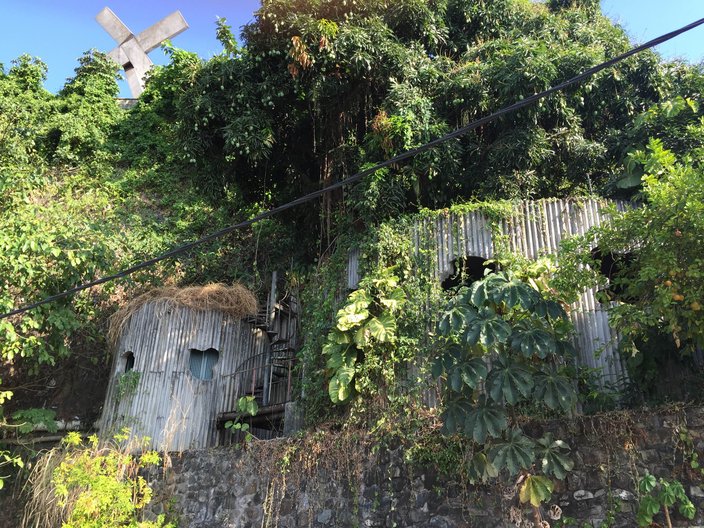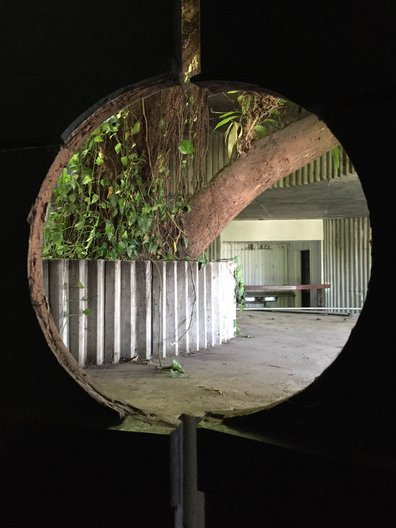16 November 2015
by Finn Beames
In this second blog post, Finn Beames, this year's Lina Bo Bardi Fellow, reports from Salvador, a city that greatly influenced Lina's work. Inspired by the unique, un-museum-like qualities of the city's Modern Art Museum, Finn reflects on Lina's still tangible presence.
Returning to the Museu de Arte Moderna da Bahia (MAM) on my last day in Salvador, I take a seat directly in front of the large central window in the main gallery, before which, on a tree stump, is a large folder. Leafing through it, I read various documents from the museum’s early and recent history -- letters from Bo Bardi requesting funding, letters withdrawing support from years later, and internal memos about restocking toilet paper due to large numbers of visitors. Glancing up, I can see through the clear heat to crawling cargo ships in the distance when, almost directly below me, a snorkeler appears from under the dilapidated pier, rising and falling in limpid water and sending miniature spindrift into the air.
This museum has a way of gently reminding you that perspective is everything, and everything is relative.The current exhibition, Academia da Crise (Academy of Crisis), not only occupies the museum but extends itself to all that is visible through the window -- international trade and mass consumption (ships) to private exploration and the almost-naked human body (snorkeler). On display are hundreds of hammers from a vast collection of a local artist, pinned to all four walls with their heads perfectly level, their worn and miscellaneous handles hanging down like furrows in a sound wave. Imagining that each hammer was used to beat in the nails holding up its neighbour, I read the following, stencilled modestly on the south wall: <<este Nosso não é um Museu>>. Lifted from Bo Bardi’s mission statement when she became the museum’s director in the sixties, this phrase is hard to translate with the economic assertion it has in Portuguese -- but the meaning is something like: <<this, our space, is not a Museum>>.
MAM certainly doesn’t feel like a <<Museum>> with an imposing capital letter, and the evidence of this is tangible. The museum’s staff, including the director, sit at desks which unapologetically skirt the high walls of the gallery. I talk to many of them about what it’s like to work in such close proximity to the art and to the public, and some say the groups of teenagers make it hard to concentrate. Others awe at the opportunity they have to see visitors, in quiet pairs, entering the space and encountering the work for the first time. They say it has a profound effect on the way they conceive of their responsibilities, and the way they make decisions. As I intimated in my last blog, I don’t have much interest in resurrecting the dead -- but of all the places the fellowship has taken me so far, Bo Bardi feels most alive here.
Curiously, or perhaps predictably, the building that has me most turned on in Salvador is Bo Bardi’s abandoned restaurant on the gated Ladeira da Misericórdia, which winds down from Pelourinho, the wilting colonial centre. After confirming our legitimacy, my guide and I are waved through by armed guards, one of whom waits outside the building as we look around. Snaking, sawtooth concrete walls curve around a large tree in the middle of the space, and we see the sea through iconic, ragged window holes. I’m told a restoration project is due to commence sometime soon, and I wonder whether they can, or will, leave the wreathes of green that swaddle the whole site.
After Salvador, I returned to Rio for a few days, to do some research into gentrification in Vidigal, a favela which pixelates the south face of the Dois Irmãos hill at the end of Leblon. Following the installation of a police pacification unit, violence is low and prices are high. Touring the neighbourhood with a local theatre artist, I learned about the hostels, and even <<5-star>> hotels, that are being erected, mostly by foreigners. It’s now not unusual for private street parties to be organised by these institutions which, with their R$80 entrance fees and R$20 beer prices, exclude everyone but tourists keen to posture against uneven brickwork for a night. By contrast, improvement in healthcare and childcare for residents is still sorely needed, and I’m told that gentrification brings little good to those who have called Vidigal home for a while.
On the beach below, which is itself dominated by a foul and massive Sheraton resort hotel, I ask myself whether the people being pushed out of Elephant & Castle would be surprised to know that gentrification is also happening in favelas in Brazil. I don’t know the answer, but I remember that I’ve read, somewhere, about Bo Bardi’s unrealised plans for social housing which was to be constructed by its occupants. Having recently been pushed out of South London myself, I begin to daydream about putting up my own four walls with hypothetical neighbours. I hide my clothes under a rock and melt into the sea like the baiano snorkeler, thinking ahead to São Paulo and the Instituto’s archives, where I hope elaboration awaits.




